Step into the chronicles of Pinkerton's storied past, where the indelible impact of remarkable operatives continues to echo through generations. This is more than just a recounting of careers, it's an exploration of the lives and contributions of those who, much like the founding Pinkertons, forged the core of Pinkerton's National Detective Agency (PNDA).
From its inception in the 1850s, Allan Pinkerton envisioned a family — a close-knit community bound by a shared mission. He valued each employee as kin, fostering an environment where loyalty and dedication were met with support and opportunity. Our archives are filled with stories of generosity and allegiance, but an early example stands out: when pioneer detective Kate Warne fell gravely ill, Allan himself tended to her, exemplifying his commitment beyond professional obligations. This familial bond translated into generations of devoted service—like George H. Bangs and his son George D. Bangs, or the Schumacher brothers—symbolizing the unique culture of trust and longevity.
In Pinkerton’s archives lies a living testament to this commitment, where lifelong careers were not uncommon, and leaders were cultivated from within. Just 100 years ago, at our landmark 75th year in 1925, we witnessed what was essentially a family reunion of Pinkerton leaders: 60 superintendents, general superintendents, and managers dedicated 5 to 15 years, 48 veterans from 15 to 30 years, and 16 stalwarts who served between 30 to 40 years. Remarkably, some served even longer, like James J. Fallon (and here), who had already been with the Agency for approximately 43 years. Our records do not show his exact start date, however, they do reveal he was active by 1887. (Isn’t that just like a shadow operative?) These aren’t just numbers, they are individual stories of commitment and service.
The Agency's approach to employee welfare was ahead of its time. Benefits such as healthcare funds, pensions, and support for families of long-term employees were not just perks but reflections of the Pinkerton ethos. The leaders provided aid through loans and gifts, ensuring that employees and their families thrived. In the 1890s, 40 years after Timothy Webster was hanged as a spy during the Civil War, Pinkerton leadership visited his widow and daughter to ensure they were cared for. When George H. Bangs passed away in 1923, William Pinkerton was so bereft that he couldn’t attend the funeral. Instead, he ensured that Bangs’ widow received her husband’s full weekly paycheck until she passed. During the 1930s Great Depression, when Joseph Stiles’s in-laws were about to lose their farm, William Pinkerton loaned them the money they needed and gave Joseph healthy pay increases, twice, in fact, in as many years.
While we salute many heroes whose tales have been told — such as Kate Warne and Timothy Webster — this yearbook gives due recognition to those once-famous alums whose names no longer fill newspaper stories but whose commitment shaped our narrative. Though we wish we could share all these stories, we turn the spotlight on a few extraordinary figures. Although not Pinkertons by blood, they embodied the spirit of the Agency and stood as pillars of its success. Their stories are the heartbeat of Pinkerton's tradition of integrity, vigilance, and excellence, echoing the profound impact of Allan Pinkerton’s dream that continues to unfold. Welcome to their legacy.
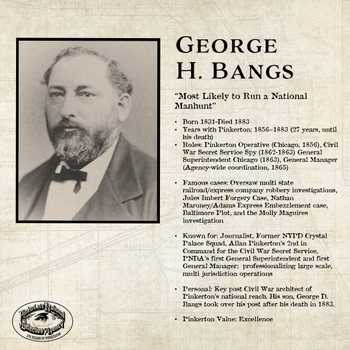
- Born 1831-Died 1883
- Years with Pinkerton: 1856–1883 (27 years, until his death)
- Roles: Pinkerton Operative (Chicago, 1856) → Civil War Secret Service Spy (1862-1863) → General Superintendent Chicago (1863) → General Manager (Agency-wide coordination, 1865)
- Famous cases: Oversaw multistate railroad/express company robbery investigations, Jules Imbert Forgery Case, Nathan Maroney/Adams Express Embezzlement case, Baltimore Plot, and the Molly Maguires investigation
- Known for: Journalist, Former NYPD Crystal Palace Squad, Allan Pinkerton’s 2nd in Command for the Civil War Secret Service, PDNA’s first General Superintendent and first General Manager; professionalizing largescale, multijurisdiction operations
- Personal: Key postCivil War architect of Pinkerton’s national reach. His son, George D. Bangs took over his post after his death in 1883.
- Pinkerton Value: Excellence
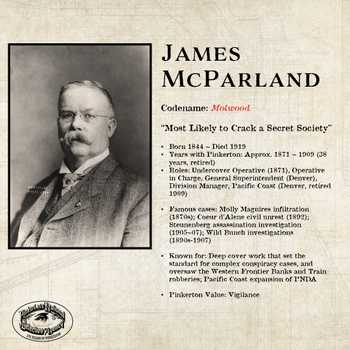
- Born 1844 – Died 1919
- Years with Pinkerton: Approx. 1871 – 1909 (38 years, retired)
- Roles: Undercover Operative (1871) → OperativeinCharge → General Superintendent (Denver) → Division Manager, Pacific Coast (Denver, retired 1909)
- Famous cases: Molly Maguires infiltration (1870s); Coeur d’Alene civil unrest (1892); Steunenberg assassination investigation (1905–07); Wild Bunch investigations (1890s-1907)
- Known for: Deepcover work that set the standard for complex conspiracy cases, and oversaw the Western Frontier Banks and Train robberies; Pacific Coast expansion of PDNA
- Pinkerton Value: Vigilance
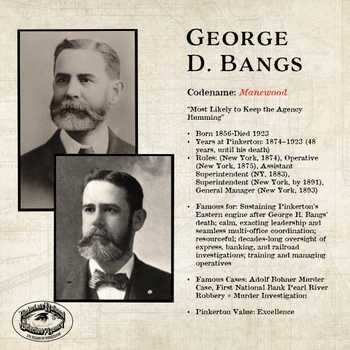
- Born 1856-Died 1923
- Years at Pinkerton: 1874–1923 (48 years, until his death)
- Roles: (New York, 1874) → Operative (New York, 1875) → Assistant Superintendent (NY, 1883) → Superintendent (New York, by 1891) → General Manager (New York, 1893)
- Famous for: Sustaining Pinkerton’s Eastern engine after George H. Bangs’ death; calm, exacting leadership and seamless multi-office coordination; resourceful; decades-long oversight of express, banking, and railroad investigations; training and managing operatives
- Famous Cases: Adolf Bohner Murder Case, First National Bank Pearl River Robbery + Murder Investigation
- Pinkerton Value: Excellence
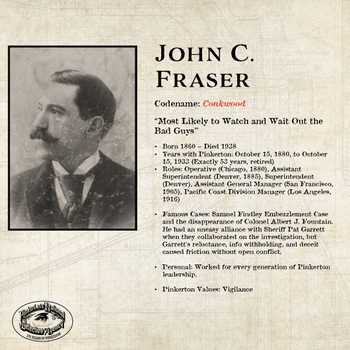
- Born 1860 – Died 1938
- Years with Pinkerton: October 15, 1880, to October 15, 1933 (Exactly 53 years, retired)
- Roles: Operative (Chicago, 1880) → Assistant Superintendent (Denver, 1885) → Superintendent (Denver) → Assistant General Manager (San Francisco, 1905) → Pacific Coast Division Manager (Los Angeles, 1916)
- Famous Cases: Samuel Findley Embezzlement Case and the disappearance of Colonel Albert J. Fountain. He had an uneasy alliance with Sheriff Pat Garrett when they collaborated on the investigation, but Garrett's reluctance, info withholding, and deceit caused friction without open conflict.
- Personal: Worked for every generation of Pinkerton leadership.
- Pinkerton Values: Vigilance
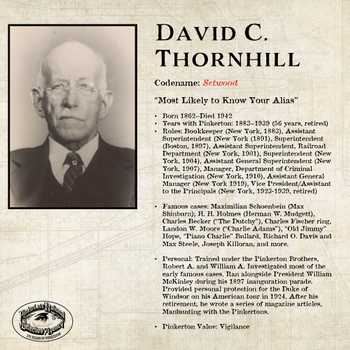
- Born 1862–Died 1942
- Years with Pinkerton: 1883–1939 (56 years, retired)
- Roles: Bookkeeper (New York, 1883) → Assistant Superintendent (New York (1891) → Superintendent (Boston, 1897) → Assistant Superintendent, Railroad Department (New York, 1901) → Superintendent (New York, 1904) → Assistant General Superintendent (New York, 1907) → Manager, Department of Criminal Investigation (New York, 1910) → Assistant General Manager (New York 1919) → Vice President/Assistant to the Principals (New York, 1923-1939, retired)
- Famous cases: Maximilian Schoenbein (Max Shinburn); H. H. Holmes (Herman W. Mudgett), Charles Becker (“The Dutchy”), Charles Fischer ring, Landon W. Moore (“Charlie Adams”), “Old Jimmy” Hope, “Piano Charlie” Bullard, Richard O. Davis and Max Steele, Joseph Killoran, and more.
- Personal: Trained under the Pinkerton Brothers, Robert A. and William A. Investigated most of the early famous cases. Ran alongside President William McKinley during his 1897 inauguration parade. Provided personal protection for the Duke of Windsor on his American tour in 1924. After his retirement, he wrote a series of magazine articles, Manhunting with the Pinkertons.
- Pinkerton Value: Vigilance
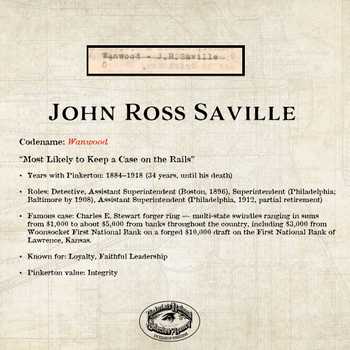
- Years with Pinkerton: 1884–1918 (34 years, until his death)
- Roles: Detective → Assistant Superintendent (Boston, 1896) → Superintendent (Philadelphia; Baltimore by 1908) → Assistant Superintendent (Philadelphia, 1912, partial retirement)
- Famous case: Charles E. Stewart forger ring — multi-state swindles ranging in sums from $1,000 to about $5,000 from banks throughout the country, including $3,000 from Woonsocket First National Bank on a forged $10,000 draft on the First National Bank of Lawrence, Kansas.
- Known for: Loyalty, Faithful Leadership
- Pinkerton value: Integrity
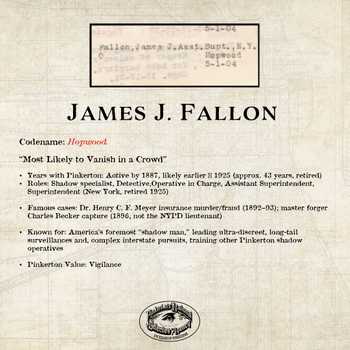
- Years with Pinkerton: Active by 1887, likely earlier → 1925 (approx. 43 years, retired)
- Roles: Shadow specialist → Detective → OperativeinCharge → Assistant Superintendent → Superintendent (New York, retired 1925)
- Famous cases: Dr. Henry C. F. Meyer insurance murder/fraud (1892–93); master forger Charles Becker capture (1896, not the NYPD lieutenant)
- Known for: America’s foremost “shadow man,” leading ultra-discreet, long-tail surveillances and →complex interstate pursuits, training other Pinkerton shadow operatives
- Pinkerton Value: Vigilance
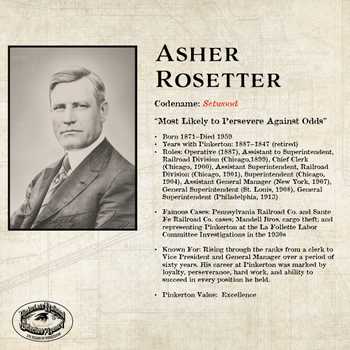
- Born 1871–Died 1959
- Years with Pinkerton: 1887–1847 (retired)
- Roles: Operative (1887) → Assistant to Superintendent, Railroad Division (Chicago,1899) → Chief Clerk (Chicago, 1900) → Assistant Superintendent, Railroad Division (Chicago, 1901) → Superintendent (Chicago, 1904) → Assistant General Manager (New York, 1907) → General Superintendent (St. Louis, 1908) → General Superintendent (Philadelphia, 1913)
- Famous Cases: Pennsylvania Railroad Co. and Sante Fe Railroad Co. cases; Mandell Bros. cargo theft; and representing Pinkerton at the La Follette Labor Committee Investigations in the 1930s
- Known For: Rising through the ranks from a clerk to Vice President and General Manager over a period of sixty years. His career at Pinkerton was marked by loyalty, perseverance, hard work, and ability to succeed in every position he held.
- Pinkerton Value: Excellence
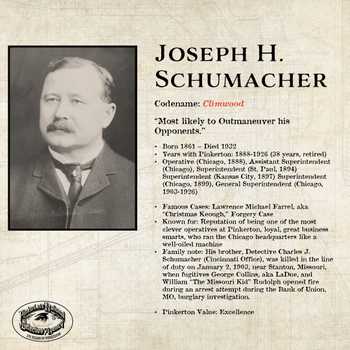
- Born 1861 – Died 1932
- Years with Pinkerton: 1888-1926 (38 years, retired)
- Operative (Chicago, 1888) → Assistant Superintendent (Chicago) → Superintendent (St. Paul, 1894) Superintendent (Kansas City, 1897) Superintendent (Chicago, 1899) → General Superintendent (Chicago, 1903-1926)
- Famous Cases: Lawrence Michael Farrel, aka “Christmas Keough,” Forgery Case
- Known for: Reputation of being one of the most clever operatives at Pinkerton, loyal, great business smarts, who ran the Chicago headquarters like a well-oiled machine
- Family note: His brother, Detective Charles J. Schumacher (Cincinnati Office), was killed in the line of duty on January 2, 1903, near Stanton, Missouri, when fugitives George Collins, aka LaDue, and William “The Missouri Kid” Rudolph opened fire during an arrest attempt during the Bank of Union, MO, burglary investigation.
- Pinkerton Value: Excellence
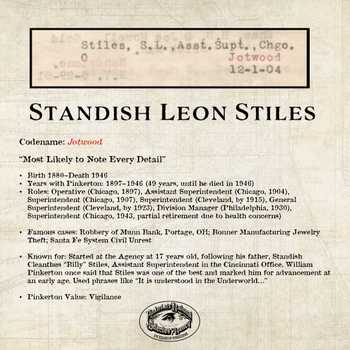
- Birth 1880–Death 1946
- Years with Pinkerton: 1897–1946 (49 years, until he died in 1946)
- Roles: Operative (Chicago, 1897) → Assistant Superintendent (Chicago, 1904) → Superintendent (Chicago, 1907) → Superintendent (Cleveland, by 1915) → General Superintendent (Cleveland, by 1923) → Division Manager (Philadelphia, 1930) → Superintendent (Chicago, 1943, partial retirement due to health concerns)
- Famous cases: Robbery of Munn Bank, Portage, OH; Bonner Manufacturing Jewelry Theft; Santa Fe System Civil Unrest
- Known for: Started at the Agency at 17 years old, following his father, Standish Cleanthus “Billy” Stiles, Assistant Superintendent in the Cincinnati Office. William Pinkerton once said that Stiles was one of the best and marked him for advancement at an early age. Used phrases like “It is understood in the Underworld…”
- Pinkerton Value: Vigilance





